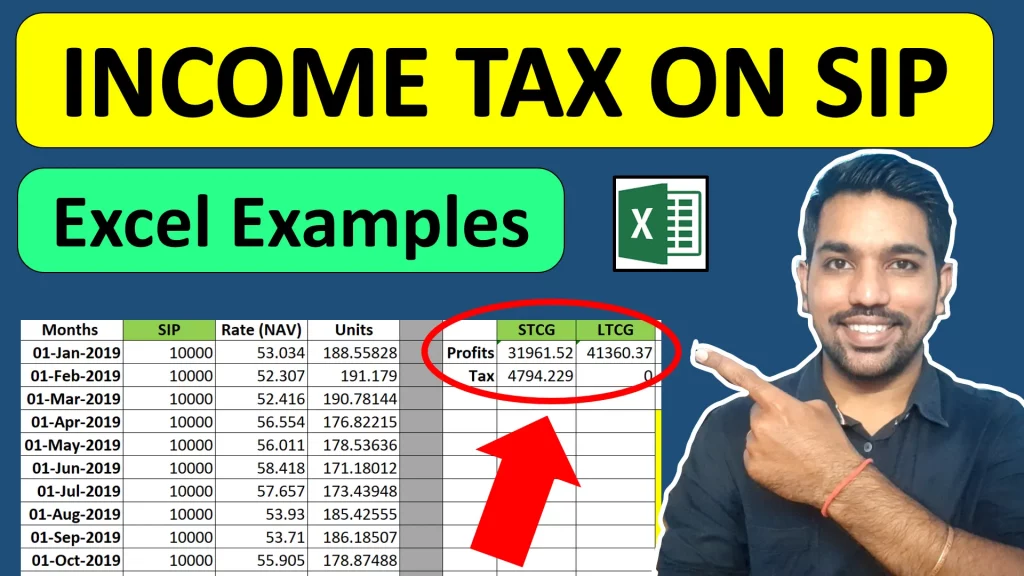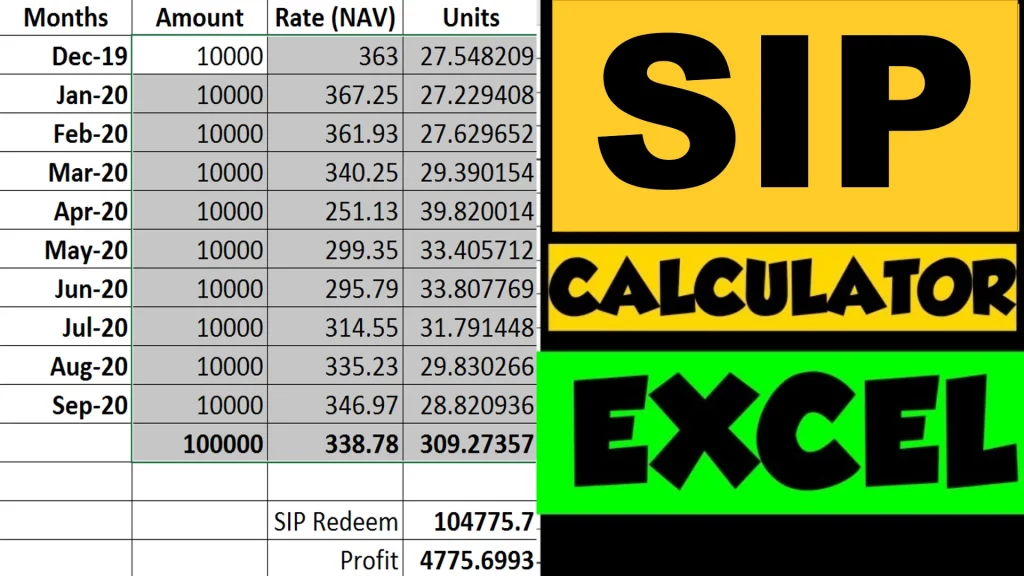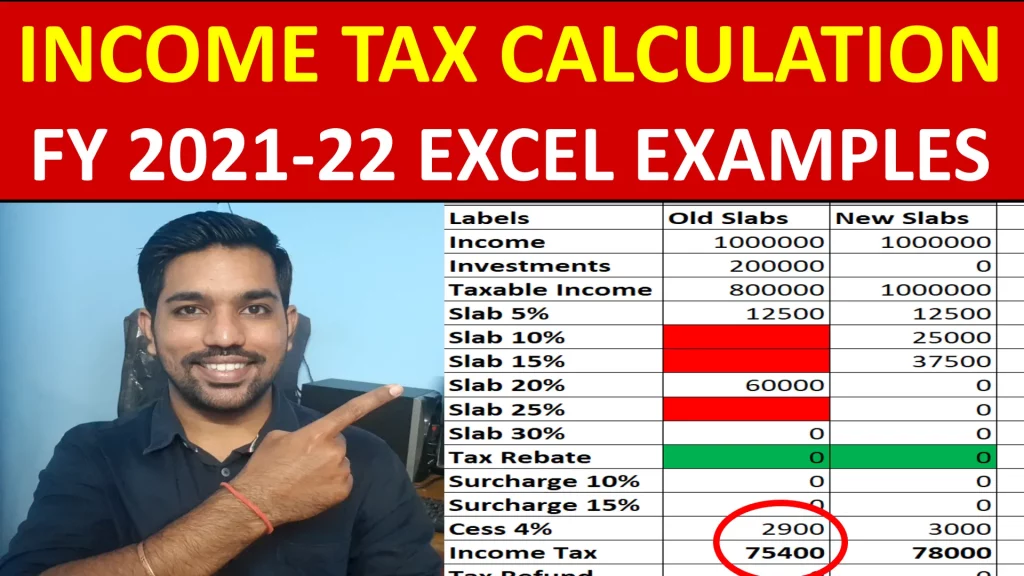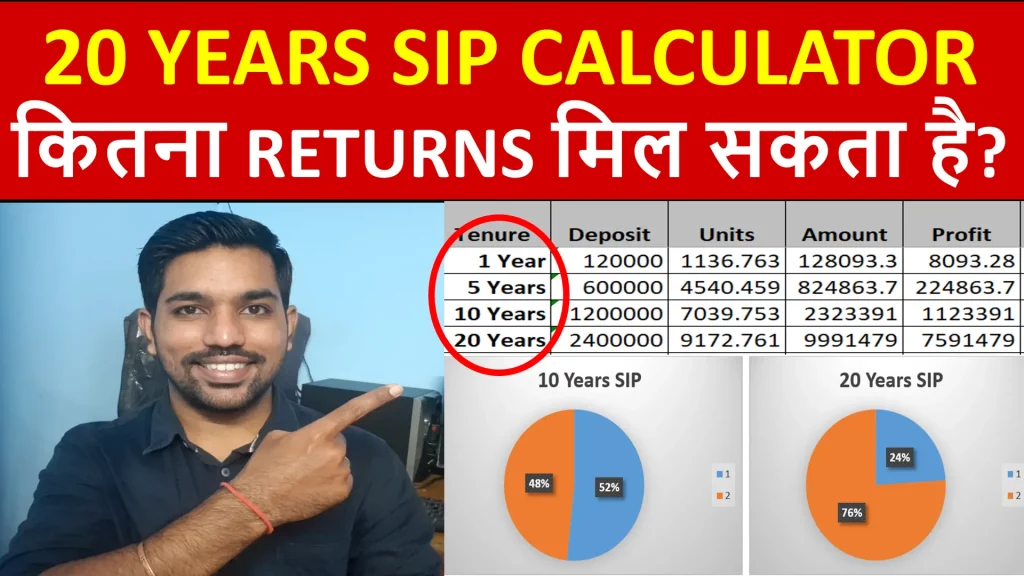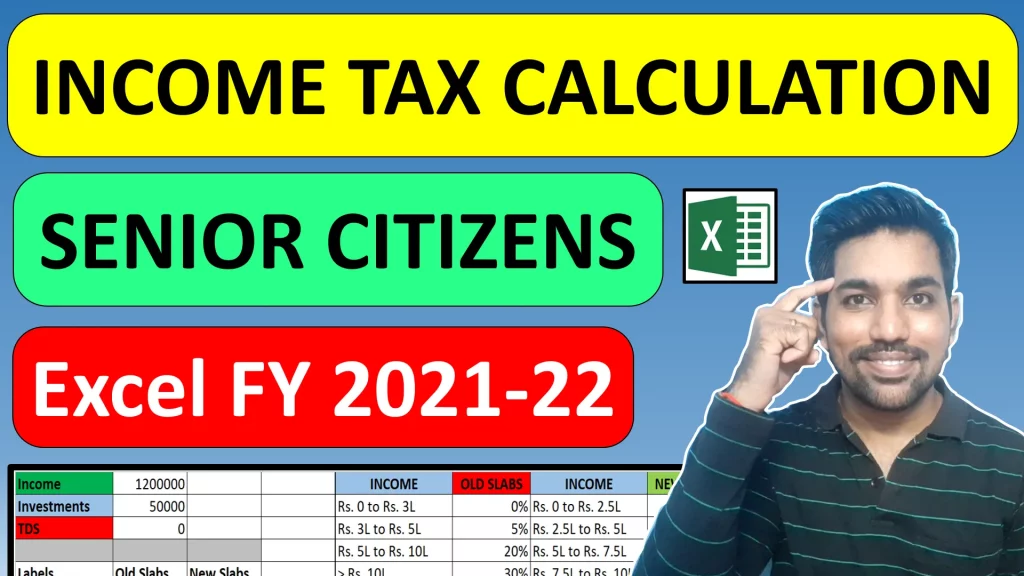One of the most asked questions on my YouTube Channel is how to calculate income tax on SIP investments? I have already made a video about Income Tax Calculation on Mutual Funds here, which covers Tax calculation on lump sum investment in mutual funds, and in this article we will see Tax Calculation on SIP investments with excel examples and answer more queries like what are the Tax rates on STCG and LTCG of SIP investments, how to calculate STCG & LTCG on SIP, Income Tax on SIP redemption, can losses be adjusted with gains and should you pay STCG or LTCG tax if your income is below Exemption limit? All these queries will be solved in this article.
Income Tax on SIP Redemption is calculated similar to lump sum investment, where we take each SIP installment as lump sum investment amount. Based on Equity or Debt mutual funds, the holding period is recognized and the gains (STCG or LTCG) are taxed based on predefined rates. The gains Tax rates are flat irrespective of which Income Tax bracket you fall under. Also, in case your income is below basic exemption limit in a financial year, you need not have to pay any Tax on STCG you make provided your total income in FY is below basic exemption limit and you are a resident Indian.
Note: You can find excel calculator at the bottom of this article.
In case you are new to how SIP works, you can read this article on SIP returns calculation along with easy to understand videos having excel calculations.
- Income Tax on SIP Redemption Video
- What are STCG & LTCG
- Tax Rates on STCG & LTCG
- STCG & LTCG on SIP
- Income Tax on SIP – Step by Step
- STCG & LTCG Tax Examples
- Adjustment of STCG against the basic exemption limit
- Adjustment of LTCG against the basic exemption limit
- Short Term Capital Loss Adjustment
- Long Term Capital Loss Adjustment
- More Videos
- DOWNLOAD INCOME TAX ON SIP EXCEL CALCULATOR
Income Tax on SIP Redemption Video

Based on above video, we can easily calculate Income tax on SIP based on STCG and LTCG segregation of individual SIP investments. and then applying Tax rates appropriately to each gains. You can also visit CAMS Official website to know about all your past SIP transactions with consolidated statement and the current portfolio amount.

What are STCG & LTCG
STCG or Short Term Capital Gains and LTCG or Long Term Capital Gains depends on whether the Gains are being calculated on Equity Mutual Funds or Debt Mutual Funds.
Equity Mutual Funds – Funds that have 65% or more exposure in Equity
Debt Mutual Funds – Funds that have 65% or more exposure in Debt instruments
Holding period for Equity Mutual Funds is considered as 1 year. So if you make gains on Equity mutual funds after holding the funds for less than 1 year, it is called STCG (Short Term Capital Gains). And if you hold Equity mutual funds for more than 1 year and make gains, than it is called LTCG (Long Term Capital Gains)
Similarly, Holding period for Debt Mutual Funds is considered as 3 years. So if you make gains on Debt mutual funds after holding the funds for less than 3 years, it is called STCG (Short Term Capital Gains). And if you hold Debt mutual funds for more than 3 years and make gains, than it is called LTCG (Long Term Capital Gains).
Note: Stocks are taxed similarly to Equity Mutual Funds
So now since you have understood how to recognize STCG and LTCG based on type of funds, let’s move to Tax rates on these gains.
Tax Rates on STCG & LTCG
Tax rates on STCG and LTCG of Equity and Debt Mutual Funds are different.
For Equity Mutual Funds
STCG Tax Rate = 15% on the gains made
LTCG Tax Rate = 10% on the gains made above Rs. 1 Lakh in a financial year
Above rates are applicable on the gains made in a financial year.
Important: LTCG Tax rate on Equity Mutual Funds are 10% on gains above Rs. 1 Lac in a financial year. Which means you don’t pay any tax on gains up to Rs. 1 Lac in a financial year. Only gains above Rs. 1 Lac in a FY are taxed at 10%
For Debt Mutual Funds
STCG Tax Rate = Added to Income and Taxed based on Income
LTCG Tax Rate = 20% Tax with Indexation benefit on the gains made
Below is the table summarizing STCG and LTCG Tax Rates for both types of Mutual funds

Love Reading Books? Here are some of the Best Books you can Read: (WITH LINKS)
STCG & LTCG on SIP
It becomes easy based on definitions to calculate STCG and LTCG on your lump sum investments. But what about SIP investments? How to calculate STCG or LTCG calculation for your SIP amounts deposited every month?
Let us understand this with the help of example. For simplicity, we will consider Equity Mutual Funds in our examples. Before moving towards examples, we assume you have some knowledge on SIP returns calculation:
STCG Calculation Example
- Let’s say you deposit Rs. 10,000 every month starting from 1st Jan 2020
- You make 12 installments – up to 1st Dec 2020
- Now if you redeem all your mutual fund units bought, on 31st Dec 2020 – you have not completed 1 year on any of your installments – so all the gains made with your SIP deposits will be considered under STCG (Short Term Capital Gains). Below screenshot shows all gains under STCG – Units marked in yellow made short term capital gains (STCG) for you.
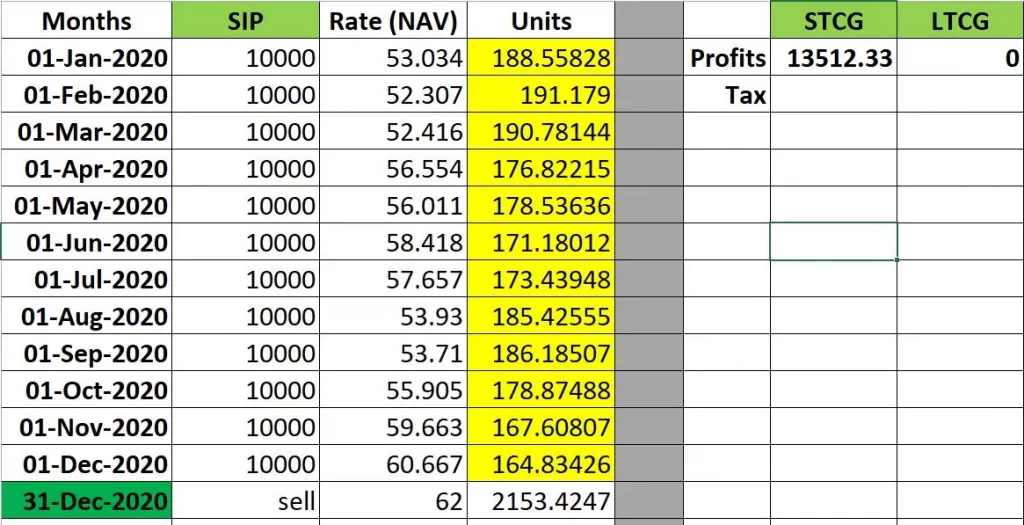
STCG & LTCG Calculation Example
Let’s consider mixture of STCG and LTCG scenario.
Let’s say for above same example, you deposit the same amount every month, but this time you redeem units on 2nd Jan 2021. In this case, only your first SIP was held for more than 1 year, others were less than a year. So units of 1st Jan investment (188.55828) will be considered for LTCG and other units will be considered for STCG, with selling price of Rs. 62 per mutual fund unit on 2nd Jan 2021. Below is the calculation: green marked units are for LTCG and yellow marked are for STCG:
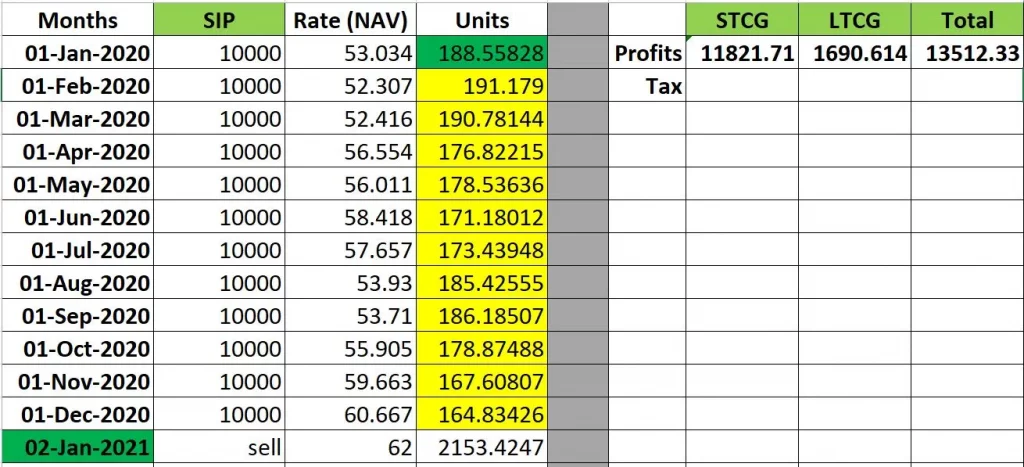
Notice that the total gains are same in this above image compared to the STCG gains of previous example. That’s because we are considering same selling price on different dates for simplicity – this divides the gains between STCG and LTCG.
LTCG Calculation Example
Let’s consider same example as above and sell all units on 31st Dec 2021 – which means all mutual fund units bought were held for more than a year. In this case all units will give us LTCG. Below is the screenshot, where green marked units give us Long term capital gains:
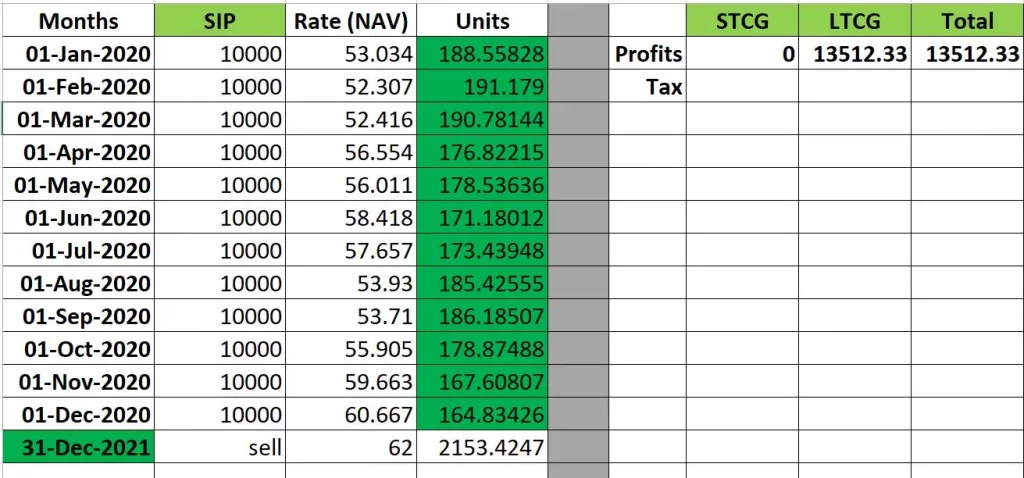
Here as well the total gains is same compared to previous 2 examples due to same selling price. This is how we calculate STCG and LTCG for individual SIP investment made. It proves that we need some tracking to reach these numbers while calculating them!
ALSO READ: 20 Years SIP Calculation using Excel
Income Tax on SIP – Step by Step
Now, the question is how do we calculate Income Tax on these Gains made.
Here are all the steps you should follow:
- Calculate your STCG and LTCG amounts based on the above examples explained
- For Equity Mutual Funds, 15% Tax will be applicable on STCG amount and 10% Tax will be applicable on LTCG gains above Rs. 1 Lac in a FY
- For Debt Mutual Funds, STCG is added in your Income and Taxed according to Tax bracket and 20% Tax with indexation is applicable on LTCG
Let’s see how these numbers help us to calculate our taxes, but before that, you can watch this video on How to calculate income tax with examples
Income Tax Calculation FY 2024-25 Video

STCG & LTCG Tax Examples
Let’s consider same example we have taken above.
For STCG Tax calculation after selling units on 2nd Jan 2021, 15% will be applicable on Rs. 11,821.71 (STCG), which is Rs. 1,773.257.

Note that we have not considered cess, distribution tax, STT, etc. in or tax calculations. These are approximate tax calculations for you to understand how SIP returns are taxed.
For LTCG tax calculation, since LTCG is below Rs. 1 Lac, you need need have to pay any tax. In case if LTCG are above Rs. 1 Lac in FY, you pay 10% of LTCG aboe Rs. 1 Lac plus applicable cess amount.
Save Income Tax on SIP Profits – Video

Watch more Videos on YouTube Channel
Adjustment of STCG against the basic exemption limit
Basic exemption limit means the level of income up to which a person is not required to pay any tax. The basic exemption limit applicable in case of an individual for the financial year 2023-24 under Old Tax Regime is as follows:
- For resident individual of the age of 80 years or above, the exemption limit is Rs. 5,00,000.
- For resident individual of the age of 60 years or above but below 80 years, the exemption limit is Rs. 3,00,000.
- For resident individual of the age below 60 years, the exemption limit is Rs. 2,50,000.
- For non-resident individual irrespective of the age of the individual, the exemption limit is Rs. 2,50,000.
Only a resident individual and resident HUF can adjust the exemption limit against
STCG covered under section 111A. Thus, a non-resident individual/HUF cannot adjust
the exemption limit against STCG covered under section 111A.
A resident individual/HUF can adjust the STCG covered under section 111A against the
basic exemption limit but such adjustment is possible only after making adjustment of
other income. In other words, first income other than STCG covered under section 111A
is to be adjusted against the exemption limit and then the remaining limit (if any) can be
adjusted against STCG covered under section 111A.
Example 1
Question: Mr. Kapoor (age 67 years and resident) is a retired person. He purchased equity shares of SBI Ltd. in March, 2021 and sold the same in May, 2021 (sold in Bombay Stock Exchange and STT is levied). Taxable STCG amounted to Rs. 1,20,000. Apart from gain on sale of shares he is not having any income. What will be his tax liability for the year 2021-22?
Answer: For resident individual of the age of 60 years and above but below 80 years, the basic exemption limit is Rs. 3,00,000. Further, a resident individual can adjust the basic exemption limit against STCG covered under section 111A. In this case, STCG of Rs. 1,20,000 is covered under section 111A, hence, the adjustment of such gain against the exemption limit is allowed only to a resident. In this case, Mr. Kapoor is a resident and, hence, he can adjust the STCG of Rs. 1,20,000 against the exemption limit.
Considering the above discussion, the tax liability of Mr. Kapoor for the year 2021-22
will be NIL.
Example 2
Question: Mr. Krunal (age 59 years equity and resident) is a retired person earning a monthly pension of Rs. 5,000. He purchased shares of SBI Ltd. in December, 2020 and sold the same in April, 2021 (sold in Bombay Stock Exchange and STT is levied). Taxable STCG amounted to Rs. 2,20,000. Apart from pension income and gain on sale of shares he is not having any other income. What will be his tax liability for the year 2021-22?
The basic exemption limit in this case is Rs. 2,50,000, after adjustment of pension income of Rs. 60,000 from the exemption limit of Rs. 2,50,000 the balance will come to Rs. 1,90,000. The balance of Rs. 1,90,000 will be adjusted against STCG.
Total STCG on sale of shares is Rs. 2,20,000 and the available exemption limit (after adjustment of pension income) is Rs. 1,90,000, hence, the balance STCG left after adjustment of Rs. 1,90,000 will come to Rs. 30,000. The gain of Rs. 30,000 will be charged to tax @ 15% (plus cess @ 4%). Thus, the tax liability before cess will come to Rs. 4,500. Since the total income of Mr Krunal is up to Rs. 5,00,000, he shall be eligible for rebate available under section 87A. Rebate shall be limited to tax payable or Rs. 12,500, whichever is less.
Adjustment of LTCG against the basic exemption limit
A resident individual can adjust the LTCG but such adjustment is possible only after making adjustment of other income. In other words, first income other than LTCG is to be adjusted against the exemption limit and then the remaining limit (if any) can be adjusted against LTCG.
LTCG will be taxed at 10% on profits above Rs. 1 Lac.
ALSO READ: SIP vs Step up SIP calculation using Excel
Short Term Capital Loss Adjustment
Can you adjust Short Term Capital loss (STCL) with gains made?
Yes, in case you have made some losses in the form of STCL, you can adjust it with STCG or LTCG. For examples, let’s say you made a STCL of Rs. 10,000 on one mutual fund, and you made STCG of Rs. 50,000 on another mutual fund.
In this case, you can adjust the loss with gain = Rs. 50,000 minus Rs. 10,000 = Rs. 40,000.
So your STCG = Rs. 40,000 on which you have to pay Income Tax + cess based on above explanations.
Long Term Capital Loss Adjustment
Similar to STCL, you can also adjust long term capital loss (LTCL).
It is important to note that LTCL can only be adjusted with LTCG and not STCG, whereas, STCL can be adjusted with both STCG and LTCG.
ALSO READ: SWP Excel Calculator – Systematic Withdrawal Plan
Some More Reading
More Videos


DOWNLOAD INCOME TAX ON SIP EXCEL CALCULATOR
Download Income Tax on SIP Excel Calculator using above link
Save Home Loan Interest Amount!
Use Home Loan Excel Calculator that will help you to Save Interest Amount on Home Loan EMI.
Click below button to download Home Loan EMI and Prepayment Calculator in Excel:
Watch how Home Loan Calculator in Excel Works
Income Tax Calculator App – FinCalC
For Income Tax Calculation on your mobile device, you can Download my Android App “FinCalC” which I have developed for you to make your income tax calculation easy.
What you can do with this mobile App?
- Calculate Income Tax for new FY 2024-25 and previous FY 2023-24
- Enter estimated Investments to check income tax with Old and New Tax Regime
- Save income tax details and track regularly
- Know how much to invest more to save income tax
- More calculators including PPF, SIP returns, Savings account interest and lot more

Use Popular Calculators:
- Income Tax Calculator
- Home Loan EMI Calculator
- SIP Calculator
- PPF Calculator
- HRA Calculator
- Step up SIP Calculator
- Savings Account Interest Calculator
- Lump sum Calculator
- FD Calculator
- RD Calculator
- Car Loan EMI Calculator
- Bike Loan EMI Calculator
- Sukanya Samriddhi Calculator
- Provident Fund Calculator
- Senior Citizen Savings Calculator
- NSC Calculator
- Monthly Income Scheme Calculator
- Mahila Samman Savings Calculator
- Systematic Withdrawal Calculator
- CAGR Calculator
I’d love to hear from you if you have any queries about Personal Finance and Money Management.
JOIN Telegram Group and stay updated with latest Personal Finance News and Topics.
Download our Free Android App – FinCalC to Calculate Income Tax and Interest on various small Saving Schemes in India including PPF, NSC, SIP and lot more.
Follow the Blog and Subscribe to YouTube Channel to stay updated about Personal Finance and Money Management topics.

